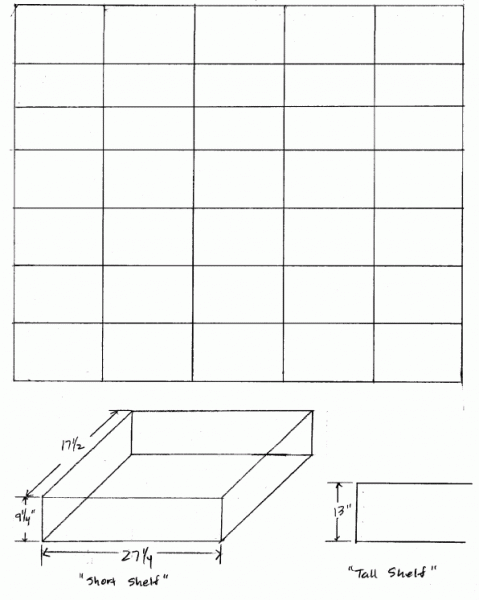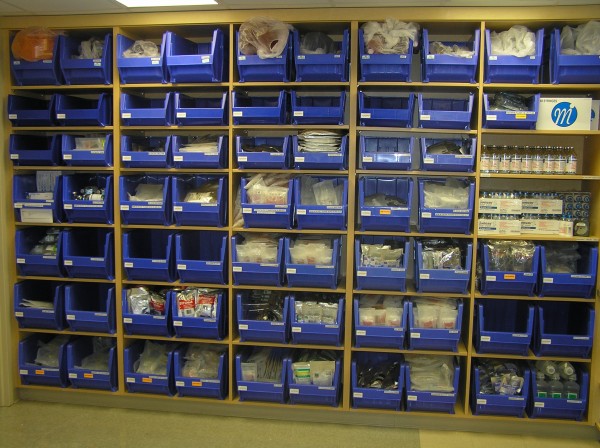In March of 2008 our hospital implemented a system to meet a district wide initiative for 100% barcoded medications in the pharmacy. The barcoding project for the pharmacy was immense, involving a pharmacy remodel, hundreds of thousands of dollars and hundreds (if not thousands) of man hours.
The project included the implementation of an automated bulk packager capable of creating unit-dosed, barcode ready medications (AutoPack), a barcode labeling system (AutoLabel) and an automated medication storage and retrieval system (AutoCarousel with AutoPharm software). All products were purchased from Talyst, who is headquartered in Bellevue, WA.
 The implementation required completely remodeling our existing pharmacy to accommodate two large AutoCarousel units. The carousels are on the small side of Talyst standards, but still sizable (89″ x 118.5″W x 64″D with approximately 145 cubic feet of storage). Photos of the installation can be found here. Based on inventory, storage needs, and our initial assessment for growth, we determined that the carousels we purchased would give us approximately 20% room for growth. From the time of the initial assessment until full implementation (approximately 12 months) we outgrew our 20% growth estimates, leaving us with virtually no “extra†room for future storage.
The implementation required completely remodeling our existing pharmacy to accommodate two large AutoCarousel units. The carousels are on the small side of Talyst standards, but still sizable (89″ x 118.5″W x 64″D with approximately 145 cubic feet of storage). Photos of the installation can be found here. Based on inventory, storage needs, and our initial assessment for growth, we determined that the carousels we purchased would give us approximately 20% room for growth. From the time of the initial assessment until full implementation (approximately 12 months) we outgrew our 20% growth estimates, leaving us with virtually no “extra†room for future storage.
The original plan for the carousels called for barcoding and storing all possible pharmacy inventory in the AutoCarousels. Doing so would allow us to take advantage of the barcoded storage and inventory control functionality of the AutoPharm software. Based on the new requirement for additional storage, we made a decision to move bulkier items out of the carousel in favor of an alternative form of storage while continuing to take advantage of the AutoPharm’s functionality.
 The plan centered around creating a remote stock area that would mimic the design of the carousel without the rotating shelves. Larger items, such as our premixed DOPamine and DOBUTamine bags, metronidazole piggybacks, etc. were deemed too bulky for storage in the carousel and relocated. An empty wall in the pharmacy became the focus of our idea to create a “virtual carousel” . The wall was fitted with adjustable shelving and had no designated use in the new pharmacy design.
The plan centered around creating a remote stock area that would mimic the design of the carousel without the rotating shelves. Larger items, such as our premixed DOPamine and DOBUTamine bags, metronidazole piggybacks, etc. were deemed too bulky for storage in the carousel and relocated. An empty wall in the pharmacy became the focus of our idea to create a “virtual carousel” . The wall was fitted with adjustable shelving and had no designated use in the new pharmacy design.
The wall is designed to match the physical layout of the shelving in the carousel, and designated RS1 (Remote Stock 1) in the AutoPharm database. The shelves are numbered from bottom to top in order (one, two, three….six). The bins are numbered left to right just as they would appear in the carousel system. Each bin is labeled with a barcode identical to bins located in the carousel, and are used to identify the location and contents of each bin. For example an order for a premixed DOPamine bag (400mg/250mL) would appear as RS1-002-02-01 (Remote Stock 1, Shelf 2, Bin 2, Slot 1).
The storage wall has drawn more attention from visitors than any other feature of our implementation. Use of the wall as a virtual carousel location has worked well for us with two exceptions. First, the shelves are more than 10 feet from the nearest carousel monitor and obscured from view. This makes it difficult for anyone pulling an item from the wall to get the immediate visual feedback of an incorrect scan (a big red ‘X’). Second, with the items not stored directly in the carousel it is easy for someone to pull an item from the shelf without scanning it, thus bypassing the entire safety of the system and creating an inventory discrepency. I hope to rememdy both issues in the near future by purchasing additional AutoPharm software and hardware (CPU, Monitor/Keyboard/Mouse, Printer, Scanner). The additional software and workstation would be used to create an new storage zone, acting independently of the carosels. A second options would be to create a mobile scanning station out of one of the current carousel workstations, utilizing a computer on wheels (COW) setup similar to what nurses use on many acute care floors throughout the hospital.
of the system and creating an inventory discrepency. I hope to rememdy both issues in the near future by purchasing additional AutoPharm software and hardware (CPU, Monitor/Keyboard/Mouse, Printer, Scanner). The additional software and workstation would be used to create an new storage zone, acting independently of the carosels. A second options would be to create a mobile scanning station out of one of the current carousel workstations, utilizing a computer on wheels (COW) setup similar to what nurses use on many acute care floors throughout the hospital.
Comments
8 responses to “Extending the reach of AutoPharm/AutoCarousel with “the wall””
I love what you did with the wall shelving. I would call it Auto-Wall. It’s wonderful that you are planning to purchase the Hardware and the software in the future (I recommend the touch-screen based Phelam Sloane station). I work for Talyst, and I hope one day I can reach out to the Development team and improve the User Interface by developing a more interactive, “Silverlight”-based application, with voice-command capability. I still need to study those feats, so it might take me a few years or so to learn it. (If you’re wondering what Silverlight is, it’s a Microsoft based application that looks similar to Flash, but has more system-wide capability and security… They can create Interfaces that you see in movies like “James Bond” or “Ironman” -those, point, drag and wave interfaces with smooth animations.)
I am a tech writer at Talyst and have enjoyed you enthusiastic writings. I do have a question for you. Have you delved into the User’s Guide and / or On-line help yet for AutoPack or AutoPharm? If so, I would greatly appreciate any and all feedback you care to share.
Regards,
Ron
I think you need another complete Talyst system. :-)
Great post.
Hi Ron,
I must admit that I have not spent much time in the User’s Guide and/or the On-line help files. During the original install (Mar 2008) I lived in the User’s Guide and found it to be ‘ok’ for the day to day operations, but lacking information for power users of the system. This is especially true for integration with automated dispensing cabinets like Pyxis. I look forward to re-visiting the User’s Guide. As I said, it’s been a while. I would love to see a monthly newsletter featuring new and improved features and customer ‘how-to’ articles. Believe me, there is always a better way and users of the system usually come up with them our of necessity. The Talyst system has much to offer, but fear that I have only scratched the surface. Thanks for visiting. Hope to hear from you again.
I love the ‘Auto-Wall’ idea, Vernard. Touch-screen work stations would be a huge improvement, and is actually one of the items on my AutoCarousel wish list. I’m always open to new and improved technology and think it’s better to be the leader rather than the follower. I also look forward to the day of creative interfaces designed for maximum functionality without loss of intuitive features. Hey, when you put something together let me know and I’ll be happy to give it my best appraisal. Thanks for the information.
@Jerry Fahrni Jerry, Ron, this would be a great opportunity for a series of tech articles via a Talyst weblog. If you’re familiar with Apple’s Developer Connection, or Microsoft’s MSDN, you get the picture.
Jerry, if Ron Fahrni is your brother who warned you to not go and see Land of the Lost and is now giving you this advice – he is a genius! Listen to him!
Rob Fahrni and my brother are in fact one in the same and he is a genius. This blog exists because he and I were discussing some things I was excited about at work and he said “you should post that.”